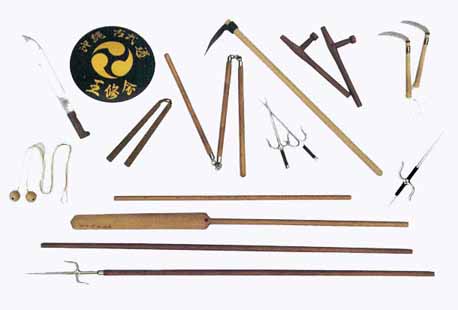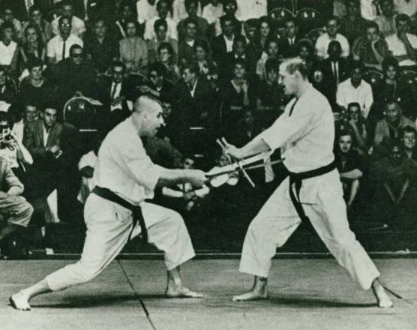
Okinawan kobudō:
Kobudō is literally translated as “ancient martial way”. In Japan this would refer to things such as the katana (sword), naginata (halbert), yari (spear), and yumi/ya (bow and arrow). To avoid confusion we refer to the Okinawan art by the full name of Okinawan kobudō or Ryūkyū kobudō. It is the indigenous weapons art of Okinawa. It is now looked at as a separate art than karate, though many styles still work them both together.
Major Okinawan buki (weapons):
- Bō – a 6 foot staff
- Sai – a three pronged truncheon
- Nunchaku – a short flail
- Tonfa – a club with a separate handle
- Kama – a sickle
- Eku – an oar
Less common Okinawan buki (weapons):
- Kuwa – Okinawan hoe
- Manji sai – sai with two striking areas and tips. The two hooks point in opposite directions
- Nunti – staff with manji sai attached to one end
- Tekkō – there are a few types. The most common is similar to brass knuckles. Second type, used in Shuri-ryū, covers the hand and has small spikes on the palm, and a hook on the pinkie edge of the hand.
- Tinbe and rochin – short spear and shield (often made from turtle shell or bronze)
- Sansetsukon – 3 section staff
- Surujin – weighted chain
Kobudō history:
One popular theory is after the Satsuma samurai clan of mainland Japan invaded Okinawa, they created a law (or continued a previous Okinawan law) prohibiting the owning and use of weapons. The peichin or warrior caste made used of tools or farm implements to train and create martial arts.
Another theory is the peichin had a strong influence from Chinese, Malaysian, and Indonesian martial arts and weaponry. And that the weapon systems were created by the nobility and the peichin based of the influences from other Asian countries and their own indigenous fighting systems. It is 100% true that there was a weapons ban in Okinawa but it is not 100% proven this is the cause of the use of the specific weapons we see today. An art called krabi-krabong from Taiwan directly influenced the art of Okinawan kobudō. A few notable kobudō masters to help develop, preserve, and/or pass down kobudō are:
- Taira Shinken
- Kishaba Chogi
- Toshihiro Oshiro
- Inoue Motokatsu
- Sakagawa Kanga
- Matayoshi Shinko
- Mabuni Kenwa
In Okinawa and Japan around World War Ⅱ so much change was happening. The Okinawan culture was being lost. The budō-ka wanted to make sure their arts were going to last throughout the upheaval. Many karate styles incorporate kobudō into their curriculum such as Isshin-ryū, Motobu-ryū, shōrin-ryū, Shuri-ryū, and some schools of gōju-ryū. This happened to help preserve both arts. They also formed kobudō styles. The major modern styles of kobudō styles are:
- Ryūkyū kobudō or Taira kobudō – founded by Taira Shinken
- Matayoshi kobudō – founded by Matayoshi Shinpo
- Yamanni-ryū – founded by Masami Chinen
- Ufuchiku kobudō – Kanagushiku Sanda

The first kobudō demonstration in the United States was done in Chicago IL in 1963. Trias ōsensei demonstrated the sai. He also is the first to teach kobudō in the US. To help kobudō knowledge expand he incorporated it into the USKA. They had their own section in the organization. Much research was put into deciding which kata and which version of a given kata would be worked and taught as the authentic USKA version of a kata many of which are still taught by the ISA or other students of Trias ōsensei.
